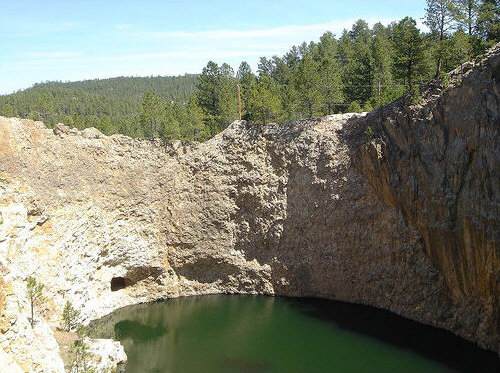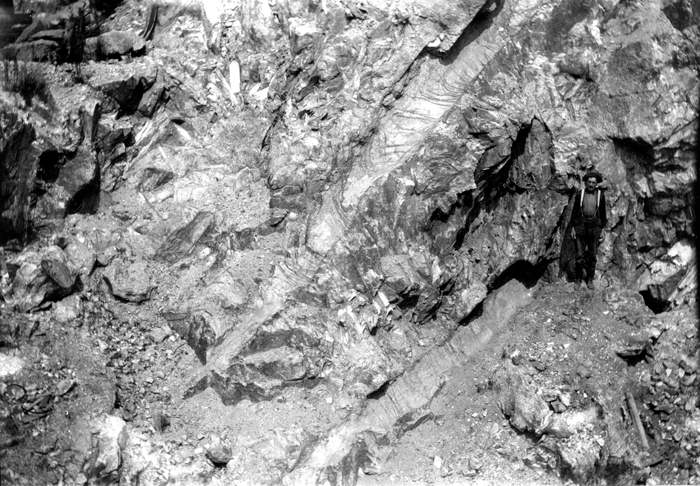

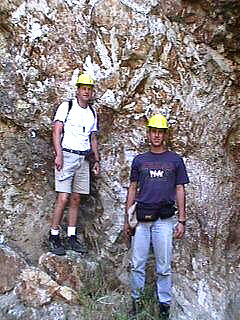
Students examining large spodumene crystals
in the Etta mine, South Dakota Photo Source : Unknown
Coordinates : 43°52'N , 103°25'W : Etta mine, Keystone, Pennington Co., South
Dakota, USA
To see the Etta Mine on Google Earth, please click here.
The Etta mine near Keystone in the Black Hills began operations
in 1883 as a mica mine. Accompanying "black ore" turned out to be rich
tin ore, triggering a tin rush in the surrounding Black Hills, which resulted in the
claiming of several other mines in the vicinity. However no substantial tin ore bodies were
discovered and most mines were abandoned soon. In the Etta however the tin boom at least proved
the existence of large quantities of lithium ores in form of large spodumene crystals, which were
mined separately since 1898.
The Etta mine operated until 1959. It became famous for its
giant spodumene crystals, which form individual "crystal logs" in a quartz
- feldspar - mica matrix. These spodumene logs reached remarkable dimensions,
whereas the first reference of the logs at the Etta mine was by Blake in
1883. A detailed survey of the mineralogy of the Etta Mine has been done by Frank Hess in
1939. He wrote : 'Huge
crystals of spodumene are mixed at every possible angle like toothpicks
in a translucent gel (quartz). In 1904, a crystal 42 feet long and
3 feet by 6 feet in cross section was found...The crystal weighed about
65 tons.'
Spodumene crystals
of similar dimension were abundantly found in the course of lithium exploitation
at Etta. Giant Spodumene crystals of up to 10 m = 30
feet were discovered also in the nearby Ingersoll mine, accompanied by
large orhoclase and beryl crystals as well as at the Tin Mountain Quarry
Today the abandoned Etta mine, with its gaping open pit, is still a spectacular
sight and large spodumene crystals can be spotted at the steep rock walls.
However the mine is on private property and visitors are generally not greeted with a warm welcome.
Though this may change, as the Etta mine was up for sale recently.
Spodumene crystal "logs" up to 14 meter size, and meter - sized feldspar crystals
Lithium and beryl rich pegmatites, direct crystallization from granitic melt
Inactive, partly flooded mine on private property A classic locality of giant crystals, now largely mined out. However, spodumene logs of considerable size
can still be observed in the walls of the open mine pit
- Another locality with giant spodumene crystals is the nearby Tin Mountain quarry, where a 10 m large spodumene crystal was discovered.
- A further well known north american spodumene locality is the Harding mine in New Mexico, where a multitude of up to 5 m long crisscrossing spodumene crystals in the pit walls are still acessible today. For more information click here.
- Gemmy spodumene of the pink variety known as kunzite can reach up to 1 m crystal size and is reported both from Brazil as well as from the Nuristan region, Pakistan
The Etta mine and many other pegmatite mines in the Black Hills have
raised geological interest since a long time and today they constitute
one of the classic geological field trip areas for many geological departments in the US.
Therefore there is a vast literature available about this area, which is probably
one of the best documented 'giant crystal areas' worldwide. To name a
few : Blake, W. P. (1884)
Transactions of the American Institute of Mining Engineers Vol. XIII: “Tin
Ore Veins of the Black Hills”.
DeWitt, E., Redden,
J. A., Burack Wilson, A., and Buscher, D. (1986) Mineral resource and geology
of the Black Hills National Forest, South Dakota and Wyoming. United States
Geological Survey Bull. 1580
Guiteras, J. R. (1940)
Mining of feldspar and associated minerals in the southern Black Hills
of South Dakota. United States Department of Interior, Bureau of Mines,
IC 7112.
Hess, F. L. (1939)
Lithium. United States Department of Interior, Bureau of Mines, IC 7054
Landes, K. L. (1928)
Sequence of Mineralization in the Keystone, South Dakota pegmatites. American
Mineralogist v. 13, p. 519.
Lincoln, F. C. (1927)
Pegmatite mining in the Black Hills. Engineering and Mining Journal
v. 123, n. 25.
O’Harra, C. C. (1902)
The mineral wealth of the Black Hills: South Dakota School of Mines Bull.
6
Roberts, W. L., and
G. Rapp Jr. (1965) Mineralogy of the Black Hills. South Dakota School
of Mines bulletin 18.
Ziegler, V. (1914)
The minerals of the Black Hills. South Dakota School of Mines bulletin
10.
Furthermore there is an excellent
online publication on the subject : Black Hills Pegmatites !!
by Thomas A. Loomis, published in : MATRIX Vol. 10, No. 3 Issue
Cross section of the Etta Mine in 1929 clearly showing the large
Rendered by G.M. Schwartz and reproduced
from Economic Geology, Vol. 20 (1925) View into the partly flooded Etta open pit Photo source : Gary Arndt at www.flickr.com Historic photo of two spodumene "logs" excavated around 1920 Photo source : United States Geological Survey

Mineralogy :
Spodumene, accompanying minerals are amblygonite, feldspar, quartz, mica and cassiterite
Maximum Crystal Size :
Geology & Formation :
Current status :
Remarks :
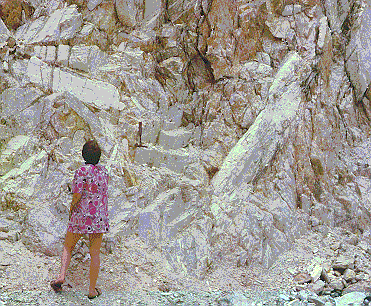
the walls of the Etta open pit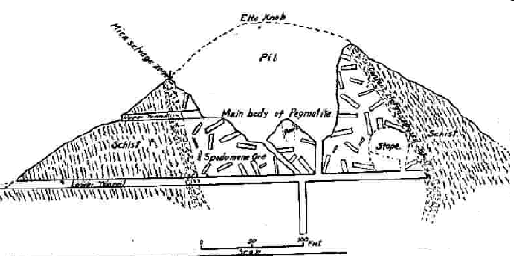
spodumene "logs" in the main pegmatite body
